About Us
Club Contacts
Junior Shooters
Upcoming Activities
Recent Activities
Member Ramblings
Books and More
Range Rules
Range Schedules
Useful Links
Website Policy

Paper Patching Cast Lead Bullets For Cartridges
March 2021 -- Jamie R.
Note from the Webmaster. Jamie R. has extensive experience in reloading cartridges for many calibers, including using bullets that he has personally cast and then resized for a custom fit in a particular barrel's bore.
In the past he has also successfully powder coated some of his cast lead bullets to reduce lead deposits in the barrel.
Here in this report he has successfully used an old technique (dating back to the 1800's) to reduce barrel leading by applying a paper patch to the bare lead bullet, resizing with lube, and then loading the completed bullet into a cartridge case.
His goal here was to make inexpensive but good quality loads for military surplus calibers, which often have a limited selection of reloading components. Photos and the following text are by Jamie.
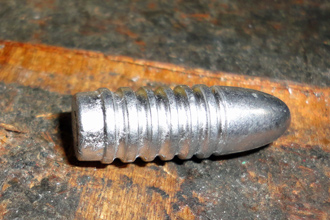
I am using a 151 grain 0.312" nominal diameter Loverin bullet (actually measured at 0.3115") that I will be shooting in a Mosin-Nagant military surplus rifle; it is weighed and checked for defects before being selected to proceed further. Consistency is important for accuracy.
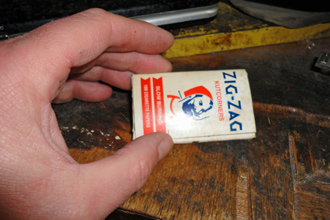
These are the rolling papers that I have been using because they are very thin with a natural fold in them.
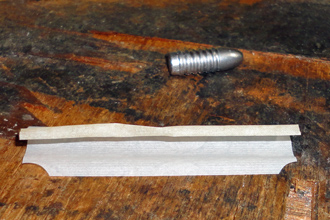
Many people using regular paper cut it into a slanted rectangle shape but I find that these papers are very easy to work with when just folded in half and lightly wet.
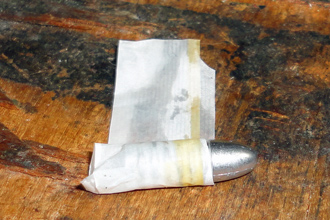
Start to roll the bullet in the paper tightly, being careful to overlap as much as possible, leaving a good amount of paper over the base of the bullet. I roll the whole length of the paper because the bullet is put through a sizer after it has dried and the paper will shrink and stick itself to the bullet.
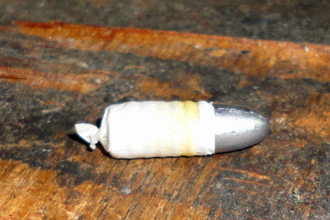
Once the bullet is wrapped, twist the excess paper at the base into a tight tail. This is very important because the excess paper and the tail form what used to be the gas check section of the base. Like most things with reloading, you have the option of starting the wrap where you want on the bullet. I like the multi lube grooves in the Loverin Bullet because I can use a lube groove as a guide while wrapping. Always leave a good amount of overhang at the base for a good tail.
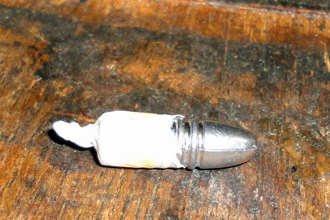
Once the bullets have sat and dried overnight, they are ready to have the tails trimmed and put through a sizing die to the diameter you want the final bullets to be for reloading. Be careful trimming the tail. You don't want to nick the paper patch on the base. This will expose the lead to the heat and cause lead fouling in your gun and probably cause a loss in accuracy. I trim the tails with sharp snips and then run them through a lube sizer that pushes the bullets from the top (nose), base downward into the sizer.
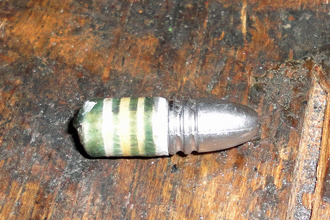
At that point you can see the lube in the grooves and the gas check groove and the bullets are ready to load. The process takes a little time but it is easy to do once you get the hang of it, and should provide good accuracy especially in military surplus (milsurp) rifles. My testing at the range with a Mosin-Nagant confirmed very good accuracy and virtually no leading.
For those that donít have lube sizers, paper patching can still work for you. Just patch the bullet to just over the desired diameter and the paper will dry and shrink to the bullet just the same. Measure the dried trimmed bullets with a micrometer and as long as you are at the desired diameter, or one thou over, tumble the bullets gently to provide a light coat of Lee Alox lube.
Let the bullets sit until dry on some wax paper, and then they are ready to load. Remember to open the case mouth slightly before seating the bullets to prevent any shaving of the paper, and apply a light crimp to the completed round when done.
Good luck, these bullets can be sized to whatever your needs are. The Loverin bullet at 151 grains can be patched and properly sized for use in all of my milsurp rifles, or any other 30 caliber bolt action or single shot rifle in good condition. With the long bearing surface you can patch high, or mid, bullet and use the many grooves as a guide. I was careful to use a safe powder load obtained from a name brand printed reloading manual. I am not sure at this time how well the paper would hold up in a semi-automatic or lever action.
back to Table Of Contents for Member Ramblings
Warning and Disclaimer. Only the most current printed Shooting Rules and Range Standing Orders and Match Standing Orders as issued by the N.O.S.A. Executive are official and they should be read, understood, and followed. If there is any question as to interpretation of a rule, or safety of a practice, immediately ask a member of the Executive or a Range Safety Officer before placing yourself or anyone or anything else at risk. Any activity involving firearms has inherent dangers. Some contents on this website may include personal opinions and experiences or practices that should not be emulated. Everyone viewing this website, or any other website or book or magazine or pamphlet or media source, is cautioned to seek professional advice first about anything written or implied or inferred. Your safety is your personal responsibility.
Copyright © 2021 New Ontario Shooters Association. This site is copyrighted and no content may be reproduced by any means, including electronic, without written permission except for strictly personal use. Other websites wishing to post a link to this site are welcome to do so.